JEE Physics Test Series Quiz-1
Quiz Summary
0 of 25 Questions completed
Questions:
Information
You have already completed the quiz before. Hence you can not start it again.
Quiz is loading…
You must sign in or sign up to start the quiz.
You must first complete the following:
Results
Results
0 of 25 Questions answered correctly
Your time:
Time has elapsed
You have reached 0 of 0 point(s), (0)
Earned Point(s): 0 of 0, (0)
0 Essay(s) Pending (Possible Point(s): 0)
Categories
- Not categorized 0%
- 1
- 2
- 3
- 4
- 5
- 6
- 7
- 8
- 9
- 10
- 11
- 12
- 13
- 14
- 15
- 16
- 17
- 18
- 19
- 20
- 21
- 22
- 23
- 24
- 25
- Current
- Review
- Answered
- Correct
- Incorrect
-
Question 1 of 25
1. Question
1 point(s)In an n-type silicon, which of the following statement is true:
CorrectIncorrect -
Question 2 of 25
2. Question
1 point(s)In a p-type silicon, which of the following statement is true:
CorrectIncorrect -
Question 3 of 25
3. Question
1 point(s)Carbon, silicon and germanium have four valence electrons each. These are characterised by valence and conduction bands separated by energy band gap respectively equal to \(\left(E_{\mathrm{g}}\right)_{\mathrm{C}},\left(E_{\mathrm{g}}\right)_{\mathrm{St}}\) and \(\left(E_{\mathrm{g}}\right)_{\mathrm{Ge}}\). Which of the following statements is true?
CorrectIncorrect -
Question 4 of 25
4. Question
1 point(s)In an unbiased p-n junction, holes diffuse from the p-region to n-region because
CorrectIncorrect -
Question 5 of 25
5. Question
1 point(s)When a forward bias is applied to a p-n junction, it
CorrectIncorrect -
Question 6 of 25
6. Question
1 point(s)In half-wave rectification, what is the output frequency if the input frequency is \(50 \mathrm{~Hz}\). What is the output frequency of a full-wave rectifier for the same input frequency.
CorrectIncorrect -
Question 7 of 25
7. Question
1 point(s)A p-n photodiode is fabricated from a semiconductor with band gap of \(2.8 \mathrm{eV}\). Can it detect a wavelength of \(6000 \mathrm{~nm}\) ?
CorrectIncorrect -
Question 8 of 25
8. Question
1 point(s)For transistor action, which of the following statements are correct:
CorrectIncorrect -
Question 9 of 25
9. Question
1 point(s)For a transistor amplifier, the voltage gain
CorrectIncorrect -
Question 10 of 25
10. Question
1 point(s)For a CE-transistor amplifier, the audio signal voltage across the collected resistance of \(2 k \Omega\) is \(2 \mathrm{~V}\). Suppose the current amplification factor of the transistor is 100 , find the input signal voltage and base current, the base resistances \(1 \mathrm{k} \Omega\).
CorrectIncorrect -
Question 11 of 25
11. Question
1 point(s)Two amplifiers are connected one after the other In series (cascade), The first amplifier has a voltage gain of 10 and the second has a voltage gain of 20 . the Input signa 0.01 volt calculate the output ac signal.
CorrectIncorrect -
Question 12 of 25
12. Question
1 point(s)The number of silicon atoms per \(\mathrm{m}^3\) is \(5 \times 10^{28}\). This is doped simultaneously with \(5 \times 10^{22}\) atoms per \(\mathrm{m}^3\) of Arsenic and \(5 \times 10^{20}\) per \(\mathrm{m}^3\) atoms of Indium. Calculate the number of electrons and holes. Given that \(n_i=1.5 \times 10^{16} \mathrm{~m}^{-3}\). Is the material n-type or p-type?
CorrectIncorrect -
Question 13 of 25
13. Question
1 point(s)In an intrinsic semiconductor the energy gap \(E_g\) is \(1.2 \mathrm{eV}\). Its hole mobility is much smaller than electron mobility and independent of temperature. What is the ratio between conductivity at \(600 \mathrm{~K}\) and that at \(300 \mathrm{~K}\) ? Assume that the temperature dependence of intrinsic carrier concentration \(n_t\) is given by
\(
n_i=n_0 \exp \left(-\frac{E_g}{2 k_B T}\right)
\)
where \(n_0\) is a constant.CorrectIncorrect -
Question 14 of 25
14. Question
1 point(s)In a p-n junction diode, the current I can be expressed as
\(
I=I_0 \exp \left(\frac{e V}{2 k_B T}-1\right)
\)
where \(I_0\) is called the reverse saturation current, \(V\) is the voltage across the diode and is positive for forward blas and negattve for reverse blas, and \(I\) is the current through the diode, \(k_B\) is the Boltzmann constant \(\left(8.6 \times 10^{-5} \mathrm{eV} / \mathrm{K}\right)\) and \(\mathrm{T}\) is the absolute temperature. If for a given diode \(I_0=5 \times 10^{-12} \mathrm{~A}\) and \(\mathrm{T}=300 \mathrm{~K}\), then What will be the forward current at a forward voltage of \(0.6 \mathrm{~V}\) ?CorrectIncorrect -
Question 15 of 25
15. Question
1 point(s)In a p-n junction diode, the current I can be expressed as
\(
I=I_0 \exp \left(\frac{e V}{2 k_B T}-1\right)
\)
where \(I_0\) is called the reverse saturation current, \(V\) is the voltage across the diode and is positive for forward blas and negattve for reverse blas, and \(I\) is the current through the diode, \(k_B\) is the Boltzmann constant \(\left(8.6 \times 10^{-5} \mathrm{eV} / \mathrm{K}\right)\) and \(\mathrm{T}\) is the absolute temperature. What will be the increase in the current if the voltage across the diode is increased to \(0.7 \mathrm{~V}\) ?If for a given diode \(I_0=5 \times 10^{-12} \mathrm{~A}\) and \(\mathrm{T}=300 \mathrm{~K}\), then What is the dynamic resistance?CorrectIncorrect -
Question 16 of 25
16. Question
1 point(s)The \(V-I\) characteristic of a silicon diode is shown in the figure below. Calculate the resistance of the diode at (a) \(I_D=15 \mathrm{~mA}\) and (b) \(V_D=-10 \mathrm{~V}\).
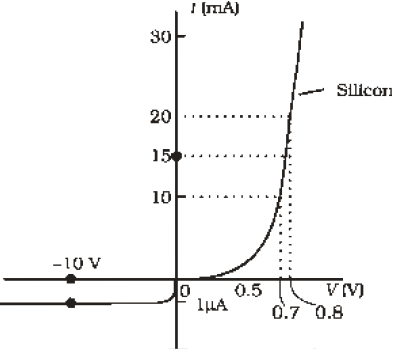 CorrectIncorrect
CorrectIncorrect -
Question 17 of 25
17. Question
1 point(s)The conductivity of a semiconductor increases with increase in temperature because
CorrectIncorrect -
Question 18 of 25
18. Question
1 point(s)In figure below, \(V_o\) is the potential barrier across a p-n junction, when no battery is connected across the junction.
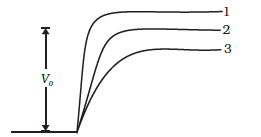 CorrectIncorrect
CorrectIncorrect -
Question 19 of 25
19. Question
1 point(s)In figure below , assuming the diodes to be ideal,
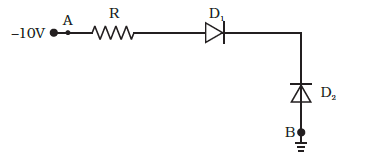 CorrectIncorrect
CorrectIncorrect -
Question 20 of 25
20. Question
1 point(s)A 220 V A.C. supply is connected between points A and B (figure below). What will be the potential difference \(V\) across the capacitor?
 CorrectIncorrect
CorrectIncorrect -
Question 21 of 25
21. Question
1 point(s)Hole is
CorrectIncorrect -
Question 22 of 25
22. Question
1 point(s)The output of the given circuit in figure below.
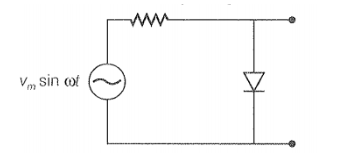 CorrectIncorrect
CorrectIncorrect -
Question 23 of 25
23. Question
1 point(s)In the circuit shown in figure below, if the diode forward voltage drop is 0.3 V, the voltage difference between A and B is
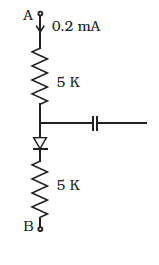 CorrectIncorrect
CorrectIncorrect -
Question 24 of 25
24. Question
1 point(s)Truth table for the given circuit below is
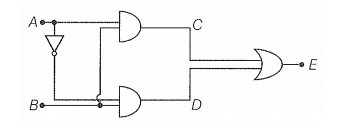
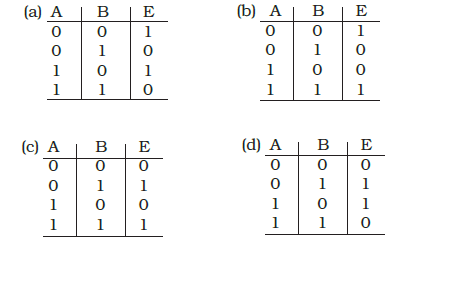 CorrectIncorrect
CorrectIncorrect -
Question 25 of 25
25. Question
1 point(s)Write the truth table for the circuit shown in figure below. Name the gate that the circuit resembles.
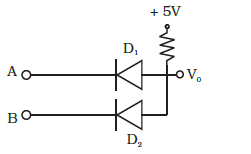 CorrectIncorrect
CorrectIncorrect